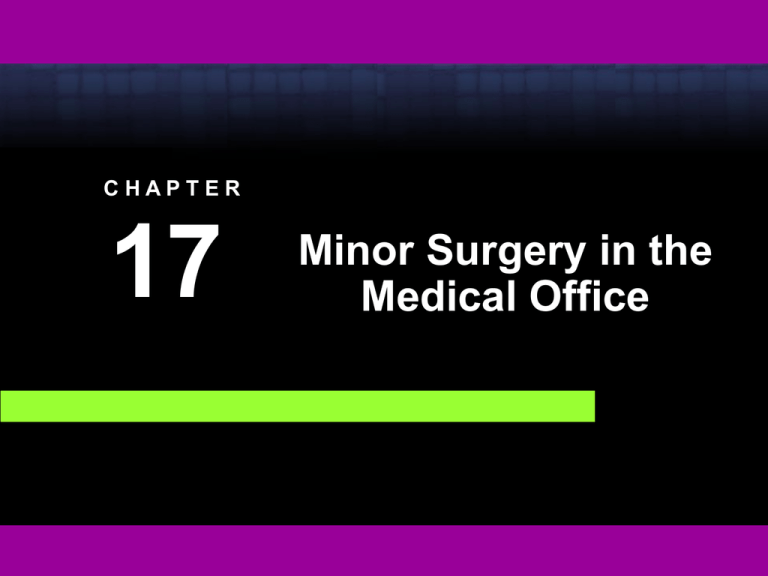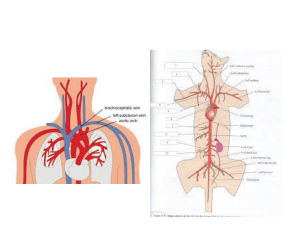
CHAPTER
17
Minor Surgery in the
Medical Office
UNIT
1
Instruments
17 - 2
Copyright © 2008 Thomson Delmar Learning, a division of Thomson Learning Inc. All rights reserved.
Instruments and Their Functions
Cutting
17 - 3
Instruments that include scissors and blades
When a blade is attached to a blade handle,
it is a cutting instrument called a scalpel.
(continued)
Copyright © 2008 Thomson Delmar Learning, a division of Thomson Learning Inc. All rights reserved.
Instruments and Their Functions
Clamping
Also called grasping instrument
Designed with ratchets
Instruments include hemostats, clamps,
forceps, and needle holders
Dilating and probing
Hold cavities or wounds open, or are used to
explore wounds
Instruments include retractors, scopes,
specula, probes, and dilators
17 - 4
Copyright © 2008 Thomson Delmar Learning, a division of Thomson Learning Inc. All rights reserved.
Parts of the Instruments and
Their Functions
17 - 5
Ring handles allow the user to insert a
thumb and finger into the rings of the
instrument.
Thumb handles are similar to tweezers
and the instrument is squeezed between
a finger and the thumb.
(continued)
Copyright © 2008 Thomson Delmar Learning, a division of Thomson Learning Inc. All rights reserved.
Parts of the Instruments and
Their Functions
Ratchets
Serrations
Fissure engraved in the surface of the
blades to prevent slipping when clamping
onto tissue
Teeth
17 - 6
Locking mechanisms that close the
instrument in several stages or degrees
Sharp projections designed to hold tissue
when grasping
(continued)
Copyright © 2008 Thomson Delmar Learning, a division of Thomson Learning Inc. All rights reserved.
Parts of the Instruments and
Their Functions
17 - 7
Copyright © 2008 Thomson Delmar Learning, a division of Thomson Learning Inc. All rights reserved.
Proper Care of Surgical Instruments
17 - 8
Blood, tissue, and other body fluids must
not be allowed to dry on the instruments.
Instruments should be soaked
immediately after each use in a solution
that is kept at room temperature and
contains both a solvent and a detergent.
(continued)
Copyright © 2008 Thomson Delmar Learning, a division of Thomson Learning Inc. All rights reserved.
Proper Care of Surgical Instruments
17 - 9
The detergent used in soaking should be
of a neutral pH to prevent corrosion of
the instrument surfaces.
Soaking solutions should also contain a
special protein to break down blood and
body fluids.
(continued)
Copyright © 2008 Thomson Delmar Learning, a division of Thomson Learning Inc. All rights reserved.
Proper Care of Surgical Instruments
17 - 10
Instruments should be soaked in plastic
containers to prevent damage to cutting
edges and points.
Separate delicate instruments from
heavy ones.
Separate sharp items from others when
cleaning and storing.
(continued)
Copyright © 2008 Thomson Delmar Learning, a division of Thomson Learning Inc. All rights reserved.
Proper Care of Surgical Instruments
Scrub all surfaces and crevices on each
instrument with a brush to remove
foreign bodies.
Carefully inspect the instrument during
cleaning to check for nicks, dullness, or
warping of the surfaces.
Repair or replace damaged instruments.
17 - 11
Copyright © 2008 Thomson Delmar Learning, a division of Thomson Learning Inc. All rights reserved.
Unit Summary
How do you identify clamping
instruments?
What is the purpose of ring handles and
ratchets?
17 - 12
Copyright © 2008 Thomson Delmar Learning, a division of Thomson Learning Inc. All rights reserved.
UNIT
2
Preoperative
Preparations
17 - 13
Copyright © 2008 Thomson Delmar Learning, a division of Thomson Learning Inc. All rights reserved.
Preoperative Instructions
17 - 14
Make sure the patient knows the date
and time of the appointment, and has
directions to the facility.
The office should also phone the patient
to confirm the appointment the day
before the scheduled procedure.
(continued)
Copyright © 2008 Thomson Delmar Learning, a division of Thomson Learning Inc. All rights reserved.
Preoperative Instructions
17 - 15
When scheduling a minor surgery, written
instructions, in the primary language of
the patient, should be given to the patient
after the verbal instructions are given.
The patient should be advised of any
special diets or medications that need to
be taken to prepare for the procedure.
(continued)
Copyright © 2008 Thomson Delmar Learning, a division of Thomson Learning Inc. All rights reserved.
Preoperative Instructions
17 - 16
The patient should also be advised about
how to dress on the day of the surgery.
In addition, transportation to and from the
office or hospital should be confirmed
with the patient.
(continued)
Copyright © 2008 Thomson Delmar Learning, a division of Thomson Learning Inc. All rights reserved.
Preoperative Instructions
The assistant should verify that the
instruments needed are ready the day
before the scheduled procedure.
The consent form should be prepared
and signatures verified prior to the
procedure.
17 - 17
Copyright © 2008 Thomson Delmar Learning, a division of Thomson Learning Inc. All rights reserved.
Obtaining the Consent Form
The medical assistant should review the
consent form with the patient and report
any concerns to the physician.
Any questions that the patient has should
be answered before signing the consent
form.
17 - 18
Copyright © 2008 Thomson Delmar Learning, a division of Thomson Learning Inc. All rights reserved.
Information That Should Be
Recorded in the Chart
Record a complete description of the
procedure, the date and time of the
procedure, and make sure that a
completed and signed consent form is in
the chart.
17 - 19
Copyright © 2008 Thomson Delmar Learning, a division of Thomson Learning Inc. All rights reserved.
Unit Summary
What should you always check when
scheduling minor office surgeries?
When do you give written instructions to
the patient?
What should you do after reviewing the
consent form?
17 - 20
Copyright © 2008 Thomson Delmar Learning, a division of Thomson Learning Inc. All rights reserved.
UNIT
3
Assisting with Minor
Surgical Procedures
17 - 21
Copyright © 2008 Thomson Delmar Learning, a division of Thomson Learning Inc. All rights reserved.
Minor Surgical Procedures
Laceration repair
Sebaceous cyst
removal
Incision and
drainage (I&D)
Biopsy
Needle biopsy
Cryosurgery
Electrosurgery and
cautery
Chemical
destruction
Laser surgery
17 - 22
Copyright © 2008 Thomson Delmar Learning, a division of Thomson Learning Inc. All rights reserved.
The Suture Removal Process
17 - 23
Copyright © 2008 Thomson Delmar Learning, a division of Thomson Learning Inc. All rights reserved.
The Staple Removal Process
Place the sterile staple extractor under a
staple.
Squeeze the handles completely closed.
Lift the staple away from the skin and
place it in a biohazard waste container.
Each staple must be removed separately
using this process.
17 - 24
Copyright © 2008 Thomson Delmar Learning, a division of Thomson Learning Inc. All rights reserved.
Anesthetics Used in Minor Surgeries
Xylocaine and Novocaine are the most
common anesthetics used.
The anesthetic is injected into the area
and begins to numb the area in
approximately 5–15 minutes.
The numbness can last up to 3 hours.
17 - 25
Copyright © 2008 Thomson Delmar Learning, a division of Thomson Learning Inc. All rights reserved.
Medical Assistant’s Duties When
Assisting in Minor Surgeries
17 - 26
Assemble the equipment and supplies.
Set up the sterile tray and cover it with a
sterile drape.
Instruct the patient on how to disrobe for
the procedure, if necessary.
(continued)
Copyright © 2008 Thomson Delmar Learning, a division of Thomson Learning Inc. All rights reserved.
Medical Assistant’s Duties When
Assisting in Minor Surgeries
Assist in positioning the patient for the
procedure.
When the physician is ready, remove the
sterile drape from the instrument tray.
If you will be assisting, wash your hands
and put on sterile drapes.
17 - 27
Copyright © 2008 Thomson Delmar Learning, a division of Thomson Learning Inc. All rights reserved.
Cleaning Up after a Minor Surgery
17 - 28
Remove gloves.
Wash hands.
Assist patient in sitting up and getting
down from the operating table.
Assist the patient in dressing, if
necessary.
(continued)
Copyright © 2008 Thomson Delmar Learning, a division of Thomson Learning Inc. All rights reserved.
Cleaning Up after a Minor Surgery
17 - 29
Review the postoperative instructions
with the patient.
Give written instructions to the patient.
Clean the exam room, clean the
instruments, and place them in the
detergent solution.
(continued)
Copyright © 2008 Thomson Delmar Learning, a division of Thomson Learning Inc. All rights reserved.
Cleaning Up after a Minor Surgery
Restock the exam room.
Dry the instrument and package it for
sterilization.
17 - 30
Copyright © 2008 Thomson Delmar Learning, a division of Thomson Learning Inc. All rights reserved.
Postoperative Instructions
and Patient Education
Usual care of patient:
17 - 31
Keep site clean.
Place no stress on the area.
Drink plenty of fluids.
Get adequate rest.
Eat a sensible diet.
Return for follow-up appointment.
(continued)
Copyright © 2008 Thomson Delmar Learning, a division of Thomson Learning Inc. All rights reserved.
Postoperative Instructions
and Patient Education
Report any of the following to the
physician:
Unusual pain, burning, or any discomfort
Swelling, redness, or other discoloration
Bleeding or other discharge
Fever above 100°F
Nausea and vomiting
Any other problem or symptom
17 - 32
Copyright © 2008 Thomson Delmar Learning, a division of Thomson Learning Inc. All rights reserved.
Unit Summary
What are two anesthetics used during
minor office surgeries?
What are the main duties of the medical
assistant during minor office surgeries?
17 - 33
Copyright © 2008 Thomson Delmar Learning, a division of Thomson Learning Inc. All rights reserved.
Keys to Career Success
Successful medical assistants always
ask to participate in any training and
learn to assist the physician in minor
office surgeries as a way of expanding
their scope of practice.
In addition, the medical assistant should
learn to explain the procedure and obtain
informed consent from the patient.
17 - 34
Copyright © 2008 Thomson Delmar Learning, a division of Thomson Learning Inc. All rights reserved.
Hot Links to Career Success
www.jarit.com
JARIT Surgical Instruments
www.miltex.com
Miltex Surgical Instruments
17 - 35
Copyright © 2008 Thomson Delmar Learning, a division of Thomson Learning Inc. All rights reserved.









